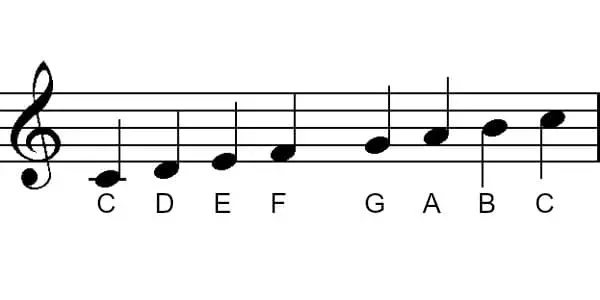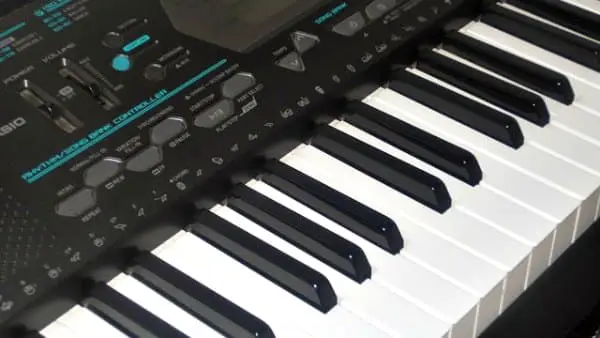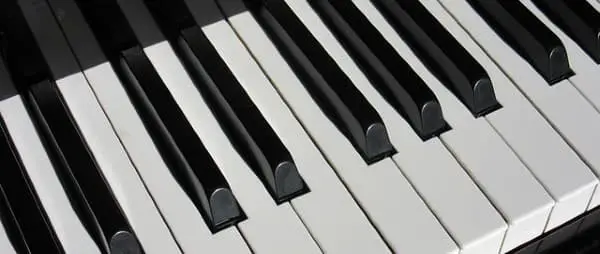- Home
- Learn to Read Music
- Treble Clef Notes
Learn to Read Treble Clef Notes & Print Free Flashcards (PDF)
This article may contain compensated links. Please read the disclosure for more info.
Enhance your musical abilities with ease! Learn to read treble clef notes in no time with this comprehensive guide. Learning how to read sheet music is an essential skill for any musician, whether you're a beginner or an experienced player. Understanding musical notation and identifying the notes on the treble clef is the first step in this journey.
In this guide, you'll have the opportunity to learn how to read treble clef notes quickly and easily. I've put together creative musical notation identification exercises to help you understand and remember the different notes on the treble clef. These exercises are designed to be fun and engaging, so you'll be able to practice and retain the information easily!
Boost Your Learning with Free Treble Clef Flashcards!
In addition to the exercises, you can print free treble clef flashcards in PDF format. These flashcards are a great way to continue practicing and consolidating your knowledge once you've finished the exercises. You can use them to quiz yourself and see how well you're doing or use them as a reference while you're practicing your instrument.
So, if you're ready to take your music reading skills to the next level, grab your free treble clef flashcards, and let's get started! Remember, the key to success is consistent and deliberate practice, so try to practice a little bit every day with the flashcards to learn how to read sheet music better.
The Treble or G Clef
The Treble clef is the symbol that shows the music notes that are higher pitched. (Treble means high pitch.) The G or Treble clef has gone through many transformations through time.
The earliest form of clefs, the F and C clefs can be traced back to the 9th century when they were used to denote the pitches in chant music. Later, when higher pitched (treble) songs became more common the G clef was introduced. Over the centuries, the symbol evolved and became more recognizable as we know it today.
The treble clef symbol, is also known as the G clef as it circles the line for the G note on the stave, indicating the position of this note. And, if you know where G is, you can then refer to it to find all the other notes on the stave! In modern music notation, the treble clef is widely used for instruments such as the violin, flute, guitar, and piano, among others. It is also used in vocal music, where the range of the music is higher.

As you can see, the Treble Clef used to be in the shape of the letter "G" but became stylized into the familiar symbol we use today. The treble clef is also called the G clef since it "circles" around the line where the note treble G is:
 G is on the second line where the clef makes a swirl.
G is on the second line where the clef makes a swirl.Music Note Names
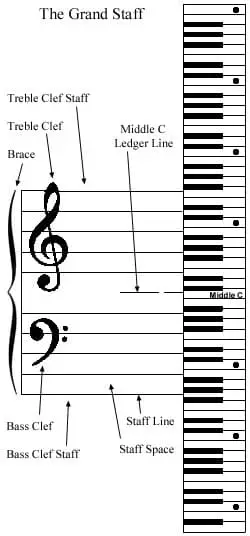 Up and Down on a piano keyboard
Up and Down on a piano keyboardOn the piano keyboard, the higher pitched notes are to the right, and the lower to the left. So, when we learn piano we say "Up, to the right", and "Down, to the left".
If you know the music alphabet; A, B, C, D, E, F, G forward and backward, and you know that the treble clef shows us G; you know all the rest of the treble clef notes as well!
Ascending (going Up) note names go forward in the alphabet A, B, C, D, E F G, descending (going Down) go backward, G F E D C B A.
- So the note one step higher than G is... A (since G is the last letter used). The next... B. And so on.
- The music note that is positioned one step lower than G is... F, then E, and so on.

If you use syllable names (Do, Re, Mi etc.) here is a quick translation:
C=Do, D=Re, E=Mi, F=Fa, G=Sol, A=La, B=Si/Ti
Using Mnemonics for Treble Clef Notes
But, of course, there are quicker ways of reading musical notation on the treble staff. One commonly used technique is using "mnemonics":
Treble Clef Notes on Lines (from bottom-up):
Every Good Boy Does Fine
Treble Clef Notes on Spaces (from bottom-up):
F, A, C, E
However, even though these mnemonics are shortcuts that may be useful in some situations, I am not a great fan of using them to learn note names because:
- Many countries do not use letter naming of the notes but use syllable names: Do, Re, Mi, Fa, Sol, La, Si/Ti. So, mnemonics like the above only work in some places.
- I want my students to immediately associate each note with where to play it on their instrument. And prefer that they learn the musical notes using "Landmarks" or "Guide Notes." I find that this method gives much better and faster results.
Using Landmark or Guide Notes
When using guide notes to learn the note names, we memorize 5 landmark notes on each staff (treble and bass) on the grand staff:
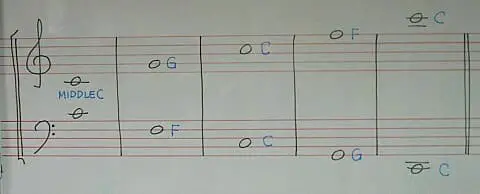 Landmark or Guide Notes
Landmark or Guide NotesHere is how to learn it:
- Middle C can be quickly learned as being in the middle of the staff (and the piano keyboard).
- The G clef shows us G, and the F clef shows us F.
- The following landmark notes are in the spaces: "High" C for the treble staff and "Low" C for the bass staff.
- Followed by the top staff line (treble) and the bottom staff line (bass). Learn like this: "The G clef shows us G. Top staff line is F." And reversed: "The F clef shows us F. Bottom staff line is G."
- The final landmarks are "very high" C and "very low" C.
In my studio, we practice these landmark or guide notes until they are memorized. Then continue with the notes next to each landmark, above and below. I have found it's easier to learn the note names much more securely this way than trying to remember wacky mnemonics (like if it was the cows that were good and the boys that ate grass? :) ).
Learn Faster With Flash Cards
Flashcards are an excellent tool for learning different music theory concepts. When using note name flashcards for drilling notes, first learn to say the note name, then immediately play the exact pitch on an instrument.
In this way, you become a better note reader (and music sight-reader) and learn faster and more securely since you use more of your senses (see, say, hear, play). You'll also learn to associate each note with a specific sound, not just by name.
Free Flashcards With Letter and Syllable Names
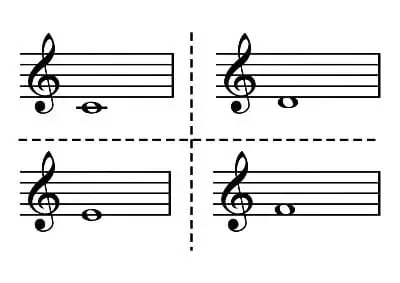
Here I have prepared free, Treble Clef Notes Printable Flash Cards PDF for you. Click on the links to download (they open in a new window):
The flash card answers have both letter names (A,B,C etc.) and syllable names (Do, Re, Mi)!
Print on both sides so that you'll have the answers on the back. Preferably use card stock for best results. Why not try paper with different colors? Have fun!
